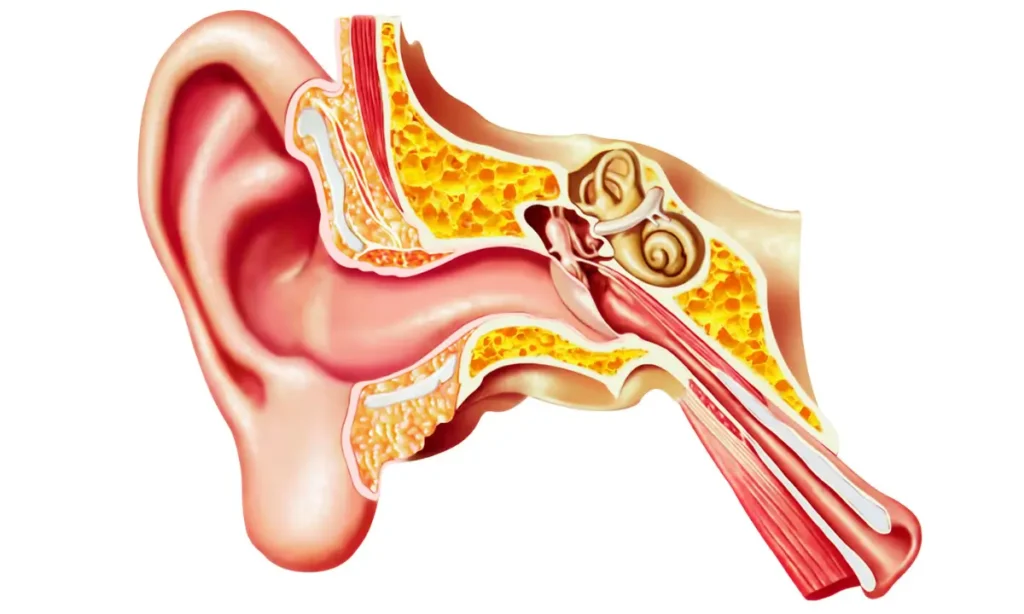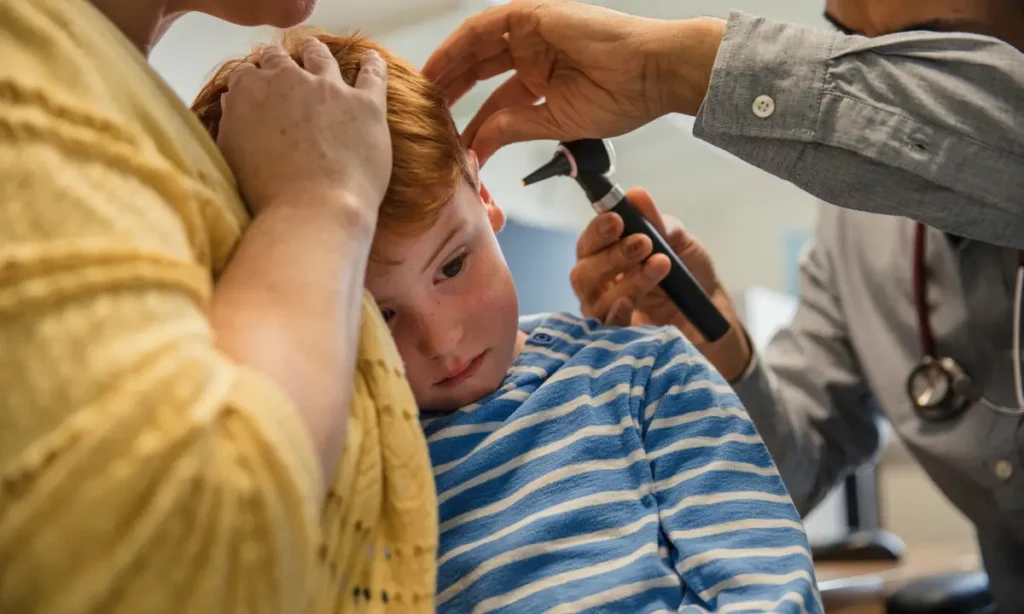Last updated on September 13th, 2024 at 01:05 pm
Table of Contents
Having a ruptured eardrum can be uncomfortable, especially when you’re trying to sleep. I know firsthand how frustrating it is to lie in bed, wondering which side to sleep on without worsening the pain or slowing down the healing process. The truth is, the position you sleep in can make all the difference when you’re dealing with a ruptured eardrum.
But don’t worry, you’re not alone in this. Many people face the same struggle every night. And the good news? There’s a way to find relief and promote faster healing just by adjusting your sleep position. In this guide, I’ll share everything you need to know about the best side to sleep on with a ruptured eardrum, why it matters, and how you can make your nights more comfortable. Let’s dive in!
Section 1: Understanding Ruptured Eardrums

Let’s start by understanding what a ruptured eardrum is. A ruptured eardrum, or tympanic membrane perforation, is when a small tear or hole forms in the thin tissue that separates your ear canal from your middle ear. This can happen due to various reasons like an ear infection, sudden pressure changes (such as during a flight or diving), loud noises, or even from cleaning your ear too aggressively.
When you have a ruptured eardrum, it can feel like more than just ear pain. You might experience hearing loss, ear drainage, or a constant ringing (also known as tinnitus). One of the worst things about it? The discomfort it causes during sleep. I remember lying in bed, not sure which way to turn my head because it felt like any pressure on my ear made things worse.
Why Sleep Position Matters
When you’re asleep, your body rests and begins to heal, and that includes your eardrum. However, the position you choose can either help the healing process or cause unnecessary strain on your ear. If you sleep on the wrong side, you might end up putting more pressure on your ruptured eardrum, which can slow down recovery or worsen your symptoms.
Section 2: The Best Sleep Position for a Ruptured Eardrum

So, the big question: Which side should I sleep on with a ruptured eardrum?
Based on personal experience and expert recommendations, it’s important to avoid sleeping directly on the affected ear. Lying on the side of the ruptured eardrum can increase pressure, worsen pain, and even slow down healing. Instead, you should sleep with the unaffected ear facing down. This helps reduce pressure on the injured ear and encourages proper drainage if there’s any fluid buildup.
Left vs. Right Side: Which is Better?
If your ruptured eardrum is on your right side, sleep on your left side. Conversely, if it’s your left ear that’s injured, sleep on your right side. This ensures that you’re not putting any additional pressure on the damaged ear. You want to keep that ear as free of pressure as possible.
What About Sleeping on Your Back?
Sleeping on your back might sound like a neutral option, but it’s not always the best choice. If you’re dealing with fluid drainage or a feeling of fullness in the ear, lying flat on your back can sometimes worsen these symptoms. However, for some people, slightly elevating the head while sleeping on the back can reduce discomfort. It’s important to try different positions to see what works best for you, but in general, I recommend sticking to sleeping on the side opposite your ruptured eardrum.
Section 3: Common Mistakes People Make

When I first dealt with a ruptured eardrum, I made a few mistakes that I now realize were slowing down my recovery. These are common, so here are some things you should avoid:
1. Sleeping Directly on the Ruptured Ear
It’s tempting to switch sides during the night, especially if you’re used to sleeping on a particular side. But if you sleep on the side with the ruptured eardrum, you’ll end up putting pressure on it. This can make the rupture worse or prevent it from healing as quickly as it should.
2. Using the Wrong Type of Pillow
The type of pillow you use can make a big difference. If your pillow is too firm, it can put more pressure on your ear. On the other hand, if it’s too soft, your head might sink too deep, causing fluid to build up in the ear. I found that a medium-firm pillow worked best for me. It gave me enough support without pressing too hard on my ear.
3. Ignoring Fluid Drainage
If your ruptured eardrum is causing fluid to drain from your ear, it’s important to position yourself so the fluid can come out naturally. If you lie down on the ruptured ear, the fluid will be trapped inside, potentially causing infections or further damage.
Section 4: Helpful Tips for Sleeping with a Ruptured Eardrum

Getting comfortable with a ruptured eardrum can be tough, but these tips made a huge difference for me:
1. Elevate Your Head
One of the easiest ways to reduce pressure on your eardrum is by elevating your head while you sleep. You can do this by propping yourself up with a couple of pillows. This helps to reduce any buildup of pressure or fluid in the ear, making it easier to rest. If you find this uncomfortable, you can try an adjustable bed wedge pillow.
2. Use Pillows Strategically
I like to surround myself with extra pillows so that I stay in the same position during the night. This is particularly helpful if you tend to roll around while sleeping. Pillows can help keep your head elevated and prevent you from accidentally sleeping on the ruptured ear.
3. Create a Restful Environment
If you’re like me, noise sensitivity can become an issue when you have a ruptured eardrum. I found that using a white noise machine helped me fall asleep more easily. The gentle background sound can mask any annoying ringing (tinnitus) in your ear.
Another tip: Keep your room cool and dark. A comfortable sleep environment helps you fall asleep faster and stay asleep longer, giving your body more time to heal.
Section 5: When to See a Doctor

Your ruptured eardrum should heal on its own in a few weeks. However, there are times when you may need to see a doctor. If your symptoms get worse, or if you notice any of the following, it might be time to get professional help:
- Persistent hearing loss
- Severe pain that doesn’t go away
- Continuous drainage from the ear (especially if it’s bloody or pus-like)
- No improvement after two weeks
Your doctor might recommend medication, ear drops, or even surgery in severe cases. Don’t wait too long if things don’t seem right – the sooner you get checked, the faster you’ll feel better.
Conclusion
Sleeping with a ruptured eardrum doesn’t have to be a nightmare. By choosing the right sleep position – usually on the side opposite the injury – and using the tips I’ve shared, you can minimize discomfort and speed up healing. Remember, avoid sleeping directly on the affected ear, elevate your head, and use pillows to keep yourself supported throughout the night.
Your body does its best healing while you sleep, so it’s important to make sure you’re sleeping in a way that helps, not hurts. If you’ve been dealing with a ruptured eardrum, try adjusting your sleep routine, and see how much better you feel in the morning.
FAQs Of Sleep with a Ruptured Eardrum
What is the best side to sleep on with a ruptured eardrum?
You should sleep on the side opposite to the ruptured eardrum to reduce pressure and promote healing.
Can I sleep on my back with a ruptured eardrum?
Yes, but it’s better to slightly elevate your head to reduce fluid buildup and discomfort.
How long does it take for a ruptured eardrum to heal?
A ruptured eardrum typically heals on its own within 1 to 3 weeks, depending on the severity.
Can sleeping on the wrong side worsen a ruptured eardrum?
Yes, sleeping on the affected ear can increase pressure and slow down the healing process.
What pillow should I use for a ruptured eardrum?
A medium-firm pillow works best to support your head without putting too much pressure on the ear.
How do I reduce ear pain while sleeping with a ruptured eardrum?
Elevate your head, use supportive pillows, and avoid sleeping directly on the ruptured ear to reduce pain.
Is it safe to sleep with ear drops for a ruptured eardrum?
Follow your doctor’s instructions regarding ear drops. Some drops are safe and can help with pain relief.
What happens if I don’t treat my ruptured eardrum?
If left untreated, it can lead to infections, hearing loss, or complications requiring surgery.
Can a ruptured eardrum cause fluid drainage while sleeping?
Yes, fluid drainage is common. Sleeping on the unaffected side helps with proper drainage.
Should I avoid loud noises while my eardrum heals?
Yes, avoid loud noises as they can delay healing and worsen symptoms.




